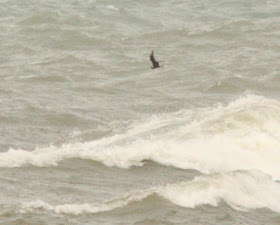I've been studying the Costa Rica book a lot and trying to puzzle out all the hyphenated combination names (e.g. Antwren, antshrike, shrike-vireo, shrike-tanager) and it seems like if Townsend's Solitaire had been named under similar conventions it would be Bluebird-thrush. Yes I know that bluebirds are technically thrushes. I chased the Solitaire that Kip had found at Warren Dunes. Brad pointed me in the right direction (a cedar stand I know they and Tim have been checking for years) and I didn't have to wait long for the bird to fly in. When I saw it flash through the bins my first impression was of a really brown mockingbird as a bird with a long tail with light edges flew away around a tree and perched out of sight. I had almost convinced myself I had somehow gripped a junco when it flew back.
After somehow not being found in the history of the county, 3 or 4 have been found in the last week. Today was the first chance I'd had to see the Sun in about 4 days so I was glad one stuck around.
It tended to perch very still and quietly on deciduous snags, or else forage very actively and mostly concealed in a berry-laden juniper.
The heavy overcast made photography fairly difficult. I may go back if there's a nice day in the next few.
As someone who doesn't go the UP very often, the only other time I've seen this bird in Michigan was a Livingston Co bird that I'm guessing was a lot of SE Michigan birders' state lifer from back in the digi-scoping days.
This was only my 4th county lifer this year; the last 2 years have scored 7 and 6 respectively, either I'm starting to reach a threshold of dimishing returns or I'm due for hopefully one more this year.
Tuesday, November 20, 2012
Friday, November 16, 2012
Not all Rednecks make moonshine
This Red-necked Grebe has been hanging out along the pier apparently for the better part of a week or so. You can just see the white leading edge to the inner upper wing that can be a helpful mark in flight.
I bet goby-belch is nasty. I'd never heard a Red-necked vocalize before; this one was giving what sounded to me like blackbird-like chack calls, very different from the gull-like calls of the Horned Grebes.
Here's a comparison shot with one of the Thumb Alcids.
A few Black Scotors have been hanging out as well, though their quarry is zebra or quagga mussels.
Finally a couple terrible record shots of a Bohemian Waxwing flock I chanced upon at Floral. I'd only seen them twice before and never in these kind of numbers.
Unfortunately they flew pretty quickly, other birds flew up from other trees. I couldn't get a shot with the entire flock, but there's about 75 sets of rufous undertail coverts in this shot.
A much closer shot of a flying-away Bohemian might make a decent photo quiz.
Monday, November 12, 2012
maybe Jaegers taste the same too.
You may remember my father-in-law from perseverative posts regarding goose subspecies. An avid outdoorsman, he told me, in tongue-in-cheek fashion, that they all tasted the same.
Horst (here with Hazel about 5 years ago (he was good at avoiding the camera)) passed away last week,;today was the first day in about a week therefore that I'd birded the lakeshore. It was pretty decent. In the midst of a good waterfowl movement a jaeger flew into my scope. The bird flew hard after a gull, cut inland, and then headed back out to sea. We ran down to the lower lip of the dune but it kept moving out so pics became quite distant.
Pomarine Jaeger is one of the most frequently rejected birds but the shape and proportions of the bird, heaviest in the breast rather than the pot-belly of a parasitic, and the wide wing base with a relatively short hand are evidence for it.
Most of the shots are fairly wing-on, though the bird banks somewhat in the 3rd from the right still, showing the paler, barred (through the scope) rump that's paler than the nape.
Bufflehead were the other remarkable bird today, usually a flock of a dozen is a decent number, today groups of 30-50 were routine. Here's an average sized one.
I've got to work the next few days, hopefully this is a year when the November 14th bird sticks around (like the murrelet, not the black-headed gull).
Horst (here with Hazel about 5 years ago (he was good at avoiding the camera)) passed away last week,;today was the first day in about a week therefore that I'd birded the lakeshore. It was pretty decent. In the midst of a good waterfowl movement a jaeger flew into my scope. The bird flew hard after a gull, cut inland, and then headed back out to sea. We ran down to the lower lip of the dune but it kept moving out so pics became quite distant.
Pomarine Jaeger is one of the most frequently rejected birds but the shape and proportions of the bird, heaviest in the breast rather than the pot-belly of a parasitic, and the wide wing base with a relatively short hand are evidence for it.
Most of the shots are fairly wing-on, though the bird banks somewhat in the 3rd from the right still, showing the paler, barred (through the scope) rump that's paler than the nape.
Bufflehead were the other remarkable bird today, usually a flock of a dozen is a decent number, today groups of 30-50 were routine. Here's an average sized one.
I've got to work the next few days, hopefully this is a year when the November 14th bird sticks around (like the murrelet, not the black-headed gull).















